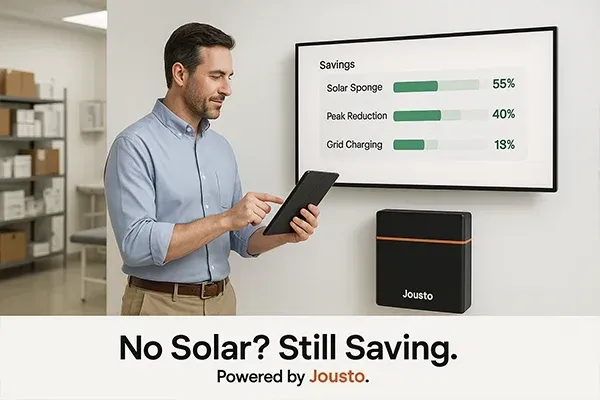Jousto Energy Hub — Start Smart. Automate Everything.
We’ve simplified home energy automation into three clear steps. Start with the Jousto Energy Hub, generate ready-to-paste YAML from our Genius chat, and if you get stuck, a vetted Fiverr expert can finish it for you.

 Smarter Energy for Everyone
Smarter Energy for Everyone
Your path to a truly smart energy home
From zero to automated in three simple steps — hardware, automations, and optional expert help.
Step 1 — Jousto Energy Hub
The Hub is your always-on energy brain. It connects solar, battery, EV, heat pump and smart plugs and runs our best-practice automations for Aussie homes.
Step 2 — Home Assistant Genius
Describe the automation you want (“charge EV from solar above 2 kW, pause on clouds, resume at 11am”). The Genius returns the exact YAML + step-by-step setup.
Step 3 — Expert help (optional)
Stuck? We’ve partnered with a vetted pool of Home Assistant experts on Fiverr. Share your YAML and brief; they’ll implement and polish.
Type your goal → Get YAML + instructions
Paste the YAML into Home Assistant and refresh. Our Genius also prints step-by-step instructions and checks common pitfalls.
Tip: Keep your device/entity names handy (e.g., sensor.solar_export_power, switch.pool_pump, climate.lounge_ac).
How it works
Connect the Hub
Plug in power + Ethernet. The Hub discovers your solar, battery, EV charger and smart devices.
Describe your automation
In the Genius, type what you want. It writes YAML and a step-by-step guide.
Paste the YAML
Load it into Home Assistant. Refresh. Toggle on. Done.
Popular automation recipes
A few prompts to try in the Genius right now.
Solar-first EV charging
“Charge EV only from excess solar above 2 kW; pause on clouds; allow grid top-up after 11pm on off-peak; target 80% by 7am weekdays.”
Smart hot water
“Run heat pump HWS 10am–3pm when exports exceed 1.5 kW; skip if tank at 55°C; force an hour at 8pm if below 45°C.”
Comfort + savings HVAC
“Pre-cool house to 23°C when solar >1 kW and outside <32°C; after 5pm hold 24–25°C using battery above 40%.”
Common questions
Do I need the Hub to use the Genius?
Will this work with my inverter/battery?
What if I can’t get the YAML working?

Why Batteries Make Sense For Business
Why Batteries Make Sense for Your Business—Even Without Solar
Save Money, Control Your Energy Costs, and Automate the Whole Process
If you're running a business in Australia, energy bills aren't just an expense—they’re often a headache.
But what if your power bill could become a strategic advantage instead?
Thanks to smarter tech and new tariffs, you can now use a battery system—with or without solar—to cut costs, protect cash flow, and stay ahead of the energy curve.
Yes, even without solar.
Here’s how.
🔄 You Can Now Charge Batteries From the Grid—And Save
In South Australia (and increasingly VIC and NSW), energy retailers now offer super-cheap power during the solar sponge (midday hours).
If you're on a Time-of-Use (TOU) or wholesale energy plan, that means:
⚡ Power during 10am–3pm can be as low as 2–5¢/kWh
🚨 Peak rates between 6am–10am and 3pm–10pm can reach 40–50¢/kWh
By charging a battery during the sponge, and using that stored energy later during peak hours, your business can:
Cut your peak grid consumption
Avoid nasty demand charges
Save thousands annually—even without panels on the roof
📊 Example: Office or Retail Site with 25kWh/day Usage
Grid charge during sponge: $1.25/day
Avoided peak power costs: ~$8–10/day
Net daily saving: ~$6–8
Annual saving: $2,000–$3,000+
And that's without solar. With solar, the savings grow even further.
🧠 Automation = Smarter, Not Harder
Sure, you could try to manage all of this manually…
…but most business owners don’t have the time.
That’s where the Jousto Energy Hub comes in.
It works quietly in the background to:
Detect sponge windows
Charge your battery at the lowest-cost times
Discharge to offset your peak usage
Keep your team focused—while it handles the smarts
💼 Which Businesses Can Benefit?
You don’t need to be running a factory to see serious savings.
Batteries make sense for:
🏥 Clinics, dental, physio, vet practices
🍽️ Cafes, bakeries, and restaurants
🏢 Small offices (legal, financial, marketing, etc.)
📦 Warehouses with fridges, forklifts, lighting
🧰 Tradie sheds or workshops
Whether you're using 15kWh or 150kWh/day, the opportunity is real.
⚙️ No Solar? No Problem
The idea that you need solar to benefit from a battery is outdated.
Today, thanks to smart plans from providers like:
Energy Locals (TOU + VPP-ready plans)
LocalVolts (wholesale + peer-to-peer energy)
You can run a battery entirely on grid-charged energy—and still come out ahead.
Want full automation?
Let the Jousto Energy Hub run the show.
💬 How to Get Started
We’ll do the heavy lifting. You’ll get:
A clear savings model based on your usage
A smart battery system with or without solar
Setup of Jousto Energy Hub + automation
Help picking the right plan (TOU or wholesale)
Ongoing support and visibility
👉 Want to see how it works for your site?
Get a commercial battery quote here →
COMPANY
PRODUCTS
SERVICES
JOUSTO ENERGY HUB
BATTERIES

© Copyright 2025.Honen Lead Generation.
All Rights Reserved.
Phone: 0489 261 333
185 Morphett St, Adelaide, SA, 5000
